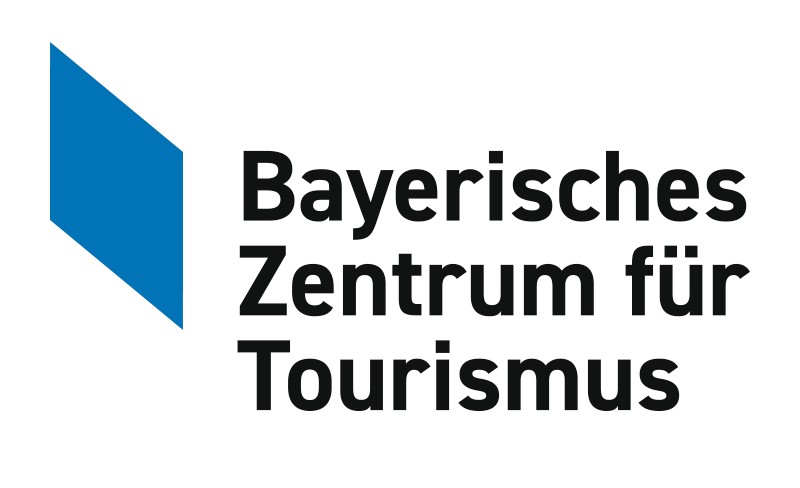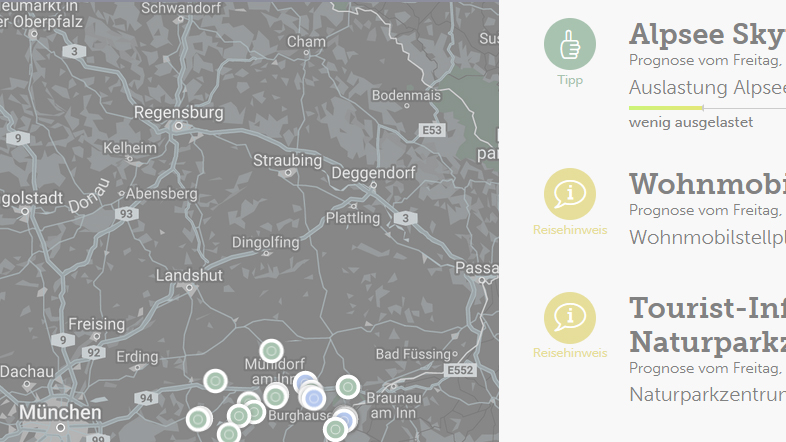SCHLAGLICHT
Schlagworte: Zielgruppen und Märkte, Mobilität, Besucherlenkung
Ausflugsticker Bayern – Einsatz und Nutzung
Von Sybille Mederle und Dr. Cathrin Schiemenz, 15. Oktober 2021
© BayTM
Einsatz des Ausflugstickers in bayerischen Kommunen
Im März 2021 wurde der Ausflugsticker 2.0 der BayTM veröffentlicht. Gemäß einer Befragung des Bayerischen Zentrums für Tourismus im April 2021 zum Thema „Bedeutung und Maßnahmen von Besucherlenkung in bayerischen Kommunen“ setzen 42 Prozent (n = 35) der befragten Gemeinden, die derzeit eine oder mehrere Besucherlenkungsmaßnahmen einsetzen, den Ausflugsticker ein, um Besucher*innen zu lenken. Dabei nutzen Kommunen, die eine Besucherlenkungsmaßnahme durchführen, zu 32 Prozent (n = 12) den Ausflugsticker; Kommunen, die mehrere Besucherlenkungsmaßnahmen einsetzen, zu 51 Prozent (n = 23) den Ausflugsticker.
Von Kommunen, die zukünftige Besucherlenkungsmaßnahmen planen, möchten 46 Prozent (n = 38) den Ausflugsticker als lenkende Maßnahme einsetzen. Unter Kommunen, die mehrere Besucherlenkungsmaßnahmen planen, liegt der Anteil bei 56 Prozent (n = 28), die sich am Ausflugsticker beteiligen möchten; unter Kommunen, die eine Maßnahme planen, sind es 30 Prozent (n = 10).
Ausflugsticker unter bayerischen Tourismusorganisationen beliebt
Laut aktuellen Auswertungen der BAYERN TOURISMUS Marketing GmbH (BayTM) verzeichnet der Ausflugsticker aktuell rund 1.300 Meldungen in seinem System. Täglich werden über die Plattform rund 400 bis 450 aktuelle Meldungen ausgespielt. Rund 50 bayerische Tourismusorganisationen/Regionen binden den Ausflugsticker in Form von Widgets auf ihrer eigenen Website ein und informieren so ihre Besucher*innen über die Situation am Ausflugsort. Bayernweit kann die BayTM bis zu 300 Melder*innen verzeichnen, die Informationen erfassen und für den Ausflugsticker verfügbar machen.
Bekanntheit und Nutzung des Bayerischen Ausflugstickers unter der bayerischen Bevölkerung
Eine bevölkerungsrepräsentative Befragung unter Bayer*innen im Mai 2021 ergab, dass sieben Prozent der Befragten den Ausflugsticker kennen und bereits genutzt haben. 17 Prozent haben bereits vom Ausflugsticker gehört, ihn jedoch bisher noch nicht genutzt. Insgesamt hat demnach ein Viertel der 18- bis 74-Jährigen vom Ausflugsticker in Bayern bereits gehört; in der Generation Z, den Geburtenjahrgänge zwischen 1995 und 2010, liegt der Anteil bei 32 Prozent. In dieser Altersgruppe haben den Ausflugsticker bereits 15 Prozent genutzt. Der Anteil männlicher Nutzer überwiegt etwas.
Der Anteil derjenigen, die vom Ausflugsticker noch nichts gehört haben, liegt bei 73 Prozent, wobei er mit 57 Prozent in der Generation Z deutlich niedriger ist als in höheren Altersgruppen. Zudem ist deutlich zu erkennen, dass die Bekanntheit des Ausflugstickers damit zusammenhängt, ob man im Jahr 2020 oder 2021 Tagesausflüge unternommen hat beziehungsweise unternehmen wird.
Die Bekanntheit und Nutzung des Ausflugstickers ist unter jenen Tagesausflügler*innen höher, die sich im Vorfeld eines Tagesausflugs informieren. Hingegen lässt sich kein Zusammenhang feststellen zwischen dem Umkreis des Tagesausflugs (km) und der Nutzung des Ausflugstickers. Unter Personen, die sich bei einem der vergangenen Tagesausflüge an etwas gestört haben, ist der Anteil derer, die den Ausflugsticker kennen beziehungsweise auch nutzen, höher als in der Gruppe der Tagesausflügler*innen, die sich bisher an nichts gestört haben.
Es lässt sich ein leichter Trend feststellen, dass mit zunehmender Wohnortgröße die Bekanntheit der Plattform und auch die Nutzung zunimmt. Auch sind Kinder im Haushalt der befragten Personen eher ein Treiber, den Ausflugsticker zu nutzen. Ebenfalls zeigt sich dieser Trend mit zunehmender Haushaltsgröße – je größer der befragte Haushalt, desto eher kennen und nutzen die Menschen den Dienst „Ausflugsticker Bayern“.
Aktuellen Zahlen der BayTM zufolge verzeichnet der „Ausflugsticker Bayern“ seit dem Launch Ende März 2021 rund 450.000 Nutzer*innen und zwei Millionen Aufrufe. Dabei können jedoch nur ca. 50 Prozent der Aufrufe gezählt werden, da die Einwilligung über den Cookie-Consent-Banner gegeben werden muss. Im Zeitverlauf zeigt sich, dass ein ansteigender Trend zur Nutzung des Ausflugstickers zu beobachten ist. Besonders häufig wird er an Wochenenden oder Feiertagen mit gutem Wetter genutzt. So hat der Ausflugsticker am ersten Augustwochenenderund 13.000 Nutzer*innen und knapp 60.000 Aufrufe verzeichnet.
Die aktuellen Auswertungen der BayTM wurden dem Bayerischen Zentrum für Tourismus freundlicherweise für diesen Beitrag zur Verfügung gestellt.


